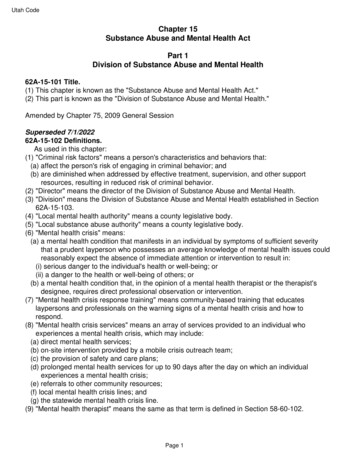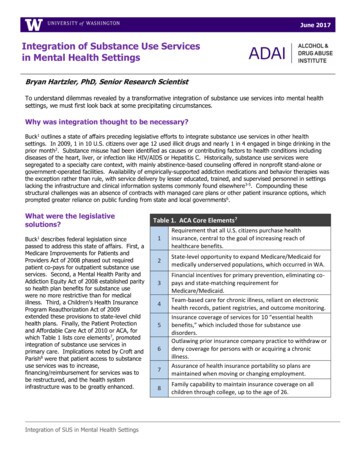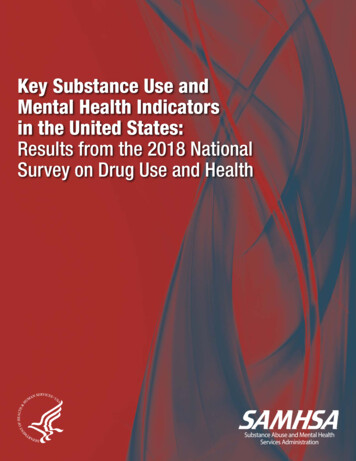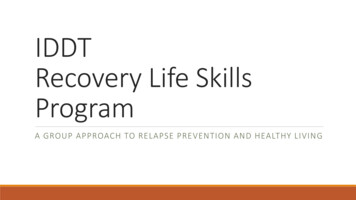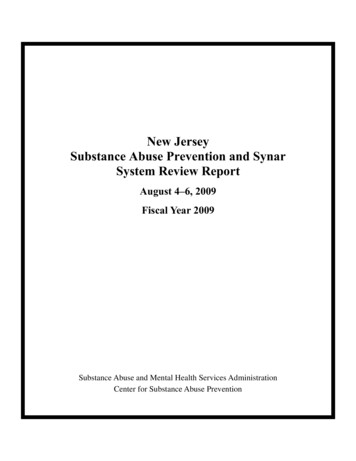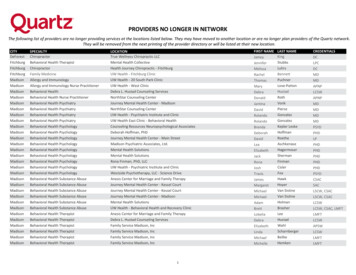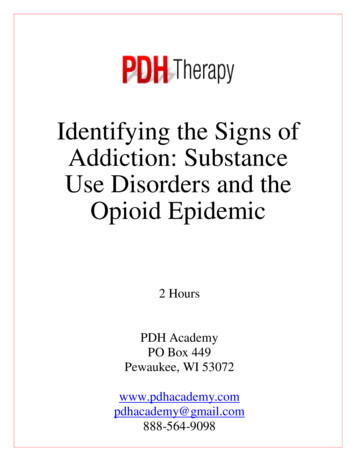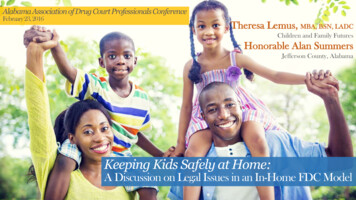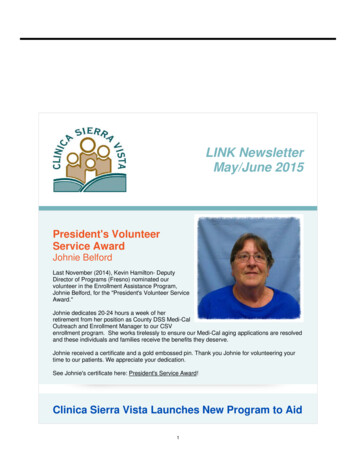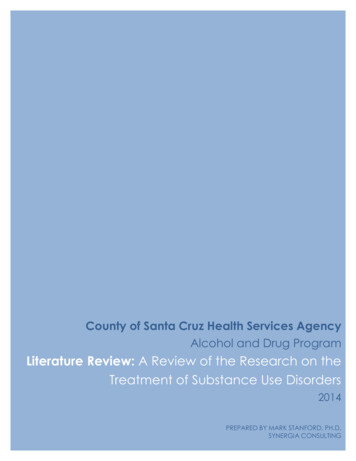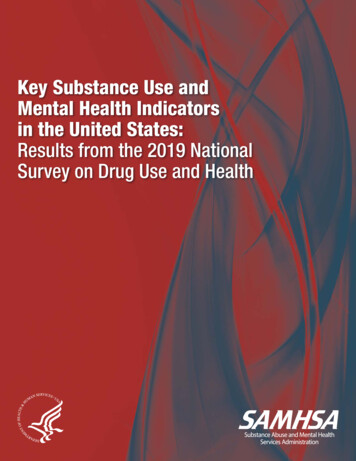
Transcription
Key Substance Use andMental Health Indicatorsin the United States:Results from the 2019 NationalSurvey on Drug Use and Health
Key Substance Use and Mental Health Indicators in the United States:Results from the 2019 National Survey on Drug Use and HealthAcknowledgmentsThis report was prepared for the Substance Abuse and Mental Health Services Administration (SAMHSA),U.S. Department of Health and Human Services (HHS), under Contract No. HHSS283201700002C withRTI International. Beth Han was the SAMHSA author. Kathryn Piscopo served as the government project officerand as the contracting officer representative.Public Domain NoticeAll material appearing in this report is in the public domain and may be reproduced or copied without permissionfrom SAMHSA. Citation of the source is appreciated. However, this publication may not be reproduced ordistributed for a fee without the specific, written authorization of the Office of Communications, SAMHSA, HHS.Electronic Access and Printed CopiesThis publication may be downloaded or ordered at https://store.samhsa.gov/. Or call SAMHSA at1-877-SAMHSA-7 (1-877-726-4727) (English and Español).Recommended CitationSubstance Abuse and Mental Health Services Administration. (2020). Key substance use and mental health indicatorsin the United States: Results from the 2019 National Survey on Drug Use and Health (HHS Publication No.PEP20-07-01-001, NSDUH Series H-55). Rockville, MD: Center for Behavioral Health Statistics and Quality,Substance Abuse and Mental Health Services Administration. Retrieved from https://www.samhsa.gov/data/Originating OfficeCenter for Behavioral Health Statistics and Quality, Substance Abuse and Mental Health Services Administration,5600 Fishers Lane, Room 15-E09D, Rockville, MD 20857. For questions about this report, please n NoticeSAMHSA complies with applicable federal civil rights laws and does not discriminate on the basis of race, color,national origin, age, disability, or sex. SAMHSA cumple con las leyes federales de derechos civiles aplicables y nodiscrimina por motivos de raza, color, nacionalidad, edad, discapacidad o sexo.U.S. Department of Health and Human ServicesSubstance Abuse and Mental Health Services AdministrationCenter for Behavioral Health Statistics and QualityPopulations Survey BranchPublication Number PEP20-07-01-001September 2020
Key Substance Use and Mental Health Indicators in the United States:Results from the 2019 National Survey on Drug Use and HealthSeptember 2020 iiiTable of ContentsSummary 1Introduction 7Survey Background 7Data Presentation and Interpretation 8Substance Use in the Past Month 8Tobacco Use in the Past Month 9Cigarette Use 10Daily Cigarette Use 10Alcohol Use in the Past Month 12Any Alcohol Use 12Binge Alcohol Use 13Heavy Alcohol Use 13Underage Alcohol Use 14Kratom Use in the Past Month 14Illicit Drug Use in the Past Year 14Any Illicit Drug Use 14Marijuana Use 15Cocaine Use 16Heroin Use 17Methamphetamine Use 18Hallucinogen Use 18Inhalant Use 19Misuse of Psychotherapeutic Drugs 20Stimulant Misuse 20Tranquilizer or Sedative Misuse 21Benzodiazepine Misuse 21Pain Reliever Misuse 22Opioid Misuse 24Initiation of Substance Use 25Initiation of Cigarette Smoking 26Initiation of Alcohol Use 26Initiation of Marijuana Use 27Initiation of Cocaine Use 28Initiation of Heroin Use 28Initiation of Methamphetamine Use 29Initiation of Hallucinogen Use 29Initiation of Inhalant Use 29Initiation of Prescription Stimulant Misuse 30Initiation of Prescription Tranquilizer or Sedative Misuse 30Initiation of Prescription Pain Reliever Misuse 31Perceived Risk from Substance Use 32Perceived Risk from Substance Use among Adolescents 33Perceived Risk from Substance Use among Young Adults 33Perceived Risk from Substance Use among Adults Aged26 or Older 33Age Comparisons for Perceived Risk from Substance Use 34Substance Use Disorders in the Past Year 34Alcohol Use Disorder 35Illicit Drug Use Disorder 35Marijuana Use Disorder 36Cocaine Use Disorder 37Heroin Use Disorder 37Methamphetamine Use Disorder 38Prescription Stimulant Use Disorder 38Prescription Tranquilizer or Sedative Use Disorder 39Prescription Pain Reliever Use Disorder 39Opioid Use Disorder 40Substance Use Disorder (Alcohol or Illicit Drugs) 40Major Depressive Episode in the Past Year 41MDE and MDE with Severe Impairment among Adolescents 42MDE and MDE with Severe Impairment among Adults 42Any Mental Illness among Adults in the Past Year 43Serious Mental Illness among Adults in the Past Year 44Co‑Occurring MDE and SUD among Adolescents 45Substance Use among Adolescents with MDE 45Co‑Occurring Mental Health Issues and SUD among Adults 46Co‑Occurring AMI and SUD 46Co‑Occurring SMI and SUD 47Substance Use among Adults, by Mental Illness Status 47Suicidal Thoughts and Behavior among Adults 48Had Serious Thoughts of Suicide 48Made a Suicide Plan 49Attempted Suicide 50Substance Use Treatment in the Past Year 50Need for Substance Use Treatment 50Receipt of Substance Use Treatment 51Perceived Need for Substance Use Treatment 53Reasons for Not Receiving Substance Use Treatment 54Medication‑Assisted Treatment for Alcohol Use or Opioid Misuse 55
iv September 2020Key Substance Use and Mental Health Indicators in the United States:Results from the 2019 National Survey on Drug Use and HealthMental Health Service Use in the Past Year 55Treatment for Depression among Adolescents 55Treatment for Depression among Adults 56Any Mental Health Service Use among Adolescents 57Any Mental Health Service Use among Adults 58Any Mental Health Service Use among Adults with AMI 59Any Mental Health Service Use among Adults with SMI 60Perceived Unmet Need for Mental Health Servicesamong Adults with Mental Illness 60Receipt of Services for Co‑Occurring Substance UseDisorder and Mental Health Issues 63Receipt of Services among Adolescents with aCo‑Occurring SUD and an MDE 63Receipt of Services among Adults with a Co‑OccurringSUD and AMI 63Receipt of Services among Adults with a Co‑OccurringSUD and SMI 64Perceived Recovery 65Endnotes 67Appendix A: Special Tables of Estimates for SubstanceUse and Mental Health Indicators in the United States A‑1Appendix B: Selected 2019 Detailed Tables ThatSupport Estimates for Key Substance Use and MentalHealth Indicators in the United States B‑1
Key Substance Use and Mental Health Indicators in the United States:Results from the 2019 National Survey on Drug Use and HealthSummaryThis report summarizes key findings from the 2019 NationalSurvey on Drug Use and Health (NSDUH) for nationalindicators of substance use and mental health among thecivilian, noninstitutionalized population aged 12 or older inthe United States. In this report, overall statements use termssuch as “increased,” “decreased,” or “declined” to describea trend from the baseline year to 2019 that was statisticallysignificant (at the .05 level) based on results of linear orquadratic trend tests. Pairwise t tests also were conducted tocompare the estimates in 2019 with corresponding estimatesin prior years.Substance Use Among people aged 12 or older in 2019, 60.1 percent(or 165.4 million people) used a substance (i.e., tobacco,alcohol, kratom, or an illicit drug) in the past month. Inparticular, 50.8 percent (or 139.7 million people) drankalcohol in the past month, 21.1 percent (or 58.1 millionpeople) used a tobacco product in the past month, and13.0 percent (or 35.8 million people) used an illicit drugin the past month. In addition, 0.3 percent (or 825,000people) used kratom in the past month.Tobacco Use Among people aged 12 or older in 2019 who usedany tobacco product in the past month, 65.3 percentsmoked cigarettes but did not use other tobaccoproducts, 13.8 percent smoked cigarettes and usedsome other type of tobacco product, and 21.0 percentused only noncigarette tobacco products (i.e., othertobacco products but not cigarettes). Thus, most of thepast month tobacco users in the United States werecigarette users. Among past month tobacco product users in 2019, thepercentage who used only cigarettes increased with age(35.4 percent of adolescents aged 12 to 17, 49.6 percentof young adults aged 18 to 25, and 68.5 percent ofadults aged 26 or older), but the percentage who usedonly noncigarette tobacco products decreased with age(39.6 percent of adolescents, 27.9 percent of youngadults, and 19.5 percent of adults aged 26 or older).September 2020 1 Among people aged 12 or older, the percentage who werepast month cigarette users declined from 26.0 percent(or 61.1 million people) in 2002 to 16.7 percent (or45.9 million people) in 2019. Among past month cigarette smokers aged 12 or older,the percentage who smoked cigarettes daily declinedfrom 63.4 percent in 2002 (or 38.7 million people) to58.4 percent (or 26.8 million people) in 2019.Alcohol Use Among the 139.7 million current alcohol users aged 12or older in 2019, 65.8 million people (47.1 percent) werepast month binge drinkers. Among past month bingedrinkers, 16.0 million people (24.4 percent of currentbinge drinkers and 11.5 percent of current alcohol users)were past month heavy drinkers. Among adolescents aged 12 to 17, the percentage whowere past month alcohol users declined from 17.6 percent(or 4.4 million people) in 2002 to 9.4 percent (or2.3 million people) in 2019. The percentage who werepast month binge alcohol users declined from 5.8 percent(or 1.4 million people) in 2015 to 4.9 percent (or1.2 million people) in 2019. Among young adults aged 18 to 25, the percentage whowere past month alcohol users declined from 61.4 percent(or 19.5 million people) in 2003 to 54.3 percent (or18.3 million people) in 2019. The percentage whowere past month binge alcohol users declined from39.0 percent (or 13.6 million people) in 2015 to34.3 percent (or 11.6 million people) in 2019. Among people aged 12 to 20, the percentage who werepast month alcohol users declined from 28.8 percent(or 10.7 million people) in 2002 to 18.5 percent (or7.0 million people) in 2019. The percentage whowere past month binge alcohol users declined from13.4 percent (or 5.1 million people) in 2015 to11.1 percent (or 4.2 million people) in 2019, and thepercentage who were past month heavy alcohol usersdeclined from 3.3 percent (or 1.3 million people) in 2015to 2.2 percent (or 825,000 people) in 2019.
2 September 2020Key Substance Use and Mental Health Indicators in the United States:Results from the 2019 National Survey on Drug Use and HealthIllicit Drug Use Among people aged 12 or older, the percentage who werepast year marijuana users increased from 11.0 percent(or 25.8 million people) in 2002 to 17.5 percent (or48.2 million people) in 2019. Over this same period, thepercentage who were past year cocaine users decreasedfrom 2.5 percent (or 5.9 million people) to 2.0 percent(or 5.5 million people). Among people aged 12 or older, the percentage who werepast year misusers of prescription pain relievers declinedfrom 4.7 percent (or 12.5 million people) in 2015 to3.5 percent (or 9.7 million people) in 2019. Among people aged 12 or older, the percentage whowere past year misusers of prescription benzodiazepinesdeclined from 2.1 percent (or 5.5 million people) in2015 to 1.8 percent (or 4.8 million people) in 2019.Among young adults aged 18 to 25, the percentage whowere past year misusers of prescription benzodiazepinesdeclined from 5.2 percent (or 1.8 million people) in 2015to 3.8 percent (or 1.3 million people) in 2019. Among adults aged 26 or older, the percentage who werepast year marijuana users increased from 7.0 percent(or 12.6 million people) in 2002 to 15.2 percent (or33.0 million people) in 2019. The percentage who werepast year hallucinogen users increased from 0.8 percent(or 1.7 million people) in 2015 to 1.5 percent (or3.1 million people) in 2019. The percentage who werepast year methamphetamine users increased from0.5 percent (or 1.1 million people) in 2016 to 0.8 percent(or 1.7 million people) in 2019.Initiation of Substance Use Among people aged 12 or older, the number of past yearinitiates of marijuana use increased from 2.2 millionpeople in 2002 to 3.5 million people in 2019. Thenumber of past year initiates of cocaine use decreasedfrom 1.0 million in 2002 to 671,000 in 2019. Among people aged 12 or older, the number of past yearinitiates of prescription pain reliever misuse declined from2.1 million people in 2015 to 1.6 million people in 2019.Over this period, the number of past year initiates ofprescription tranquilizer misuse declined from 1.4 millionpeople to 949,000 people, and the number of past yearinitiates of prescription stimulant misuse declined from1.3 million people to 901,000 people. Among adolescents aged 12 to 17, the number ofpast year initiates of cigarette smoking declined from1.2 million people in 2002 to 541,000 people in 2019.Over this same period, the number of past year initiatesof alcohol use declined from 2.6 million adolescents to2.3 million adolescents, and the number of past yearinitiates of cocaine use decreased from 310,000adolescents to 59,000 adolescents. The number ofadolescents who were past year initiates of prescriptionpain reliever misuse declined from 415,000 in 2015 to245,000 in 2019. Among young adults aged 18 to 25, the numberof past year initiates of alcohol use increased from1.2 million people in 2002 to 2.4 million people in 2019.Over this same period, the number of past year initiatesof marijuana use increased from 733,000 young adultsto 1.2 million young adults. The number of young adultswho were past year initiates of prescription pain relievermisuse declined from 596,000 in 2015 to 404,000 in2019. Among adults aged 26 or older, the number of past yearinitiates of marijuana use increased from 90,000 peoplein 2002 to 887,000 people in 2019, but the number ofpast year initiates of prescription pain reliever misuseremained stable between 2015 and 2019.Perceived Risk from Substance Use Among adolescents aged 12 to 17, perceived great riskof harm from smoking marijuana weekly declined from40.6 percent in 2015 to 34.6 percent in 2019, andperceived great risk of harm from smoking one or morepacks of cigarettes per day declined from 68.2 percent to65.0 percent over this same period. Among young adults aged 18 to 25, perceived great riskof harm from smoking marijuana weekly declined from19.1 percent in 2015 to 15.0 percent in 2019. Among adults aged 26 or older, perceived great risk ofharm from smoking marijuana weekly declined from38.7 percent in 2015 to 30.8 percent in 2019.
Key Substance Use and Mental Health Indicators in the United States:Results from the 2019 National Survey on Drug Use and HealthSubstance Use Disorders Among people aged 12 or older, the percentage witha past year substance use disorder (SUD) (i.e., alcoholuse disorder, illicit drug use disorder, or both) remainedstable between 2015 and 2019. Among the 20.4 millionpeople aged 12 or older with a past year SUD in 2019,71.1 percent (or 14.5 million people) had a past yearalcohol use disorder, 40.7 percent (or 8.3 million people)had a past year illicit drug use disorder, and 11.8 percent(or 2.4 million people) had both an alcohol use disorderand an illicit drug use disorder in the past year. Among people aged 12 or older, the percentage with apast year alcohol use disorder declined from 7.7 percent(or 18.1 million people) in 2002 to 5.3 percent (or14.5 million people) in 2019. Over that same period, thepercentage with a past year cocaine use disorder declinedfrom 0.6 percent (or 1.5 million people) to 0.4 percent(or 1.0 million people). Among people aged 12 or older, the percentage with apast year prescription pain reliever use disorder decreasedfrom 0.8 percent (or 2.0 million people) in 2015 to0.5 percent (or 1.4 million people) in 2019. Over thatsame period, the percentage with a past year opioid usedisorder also decreased from 0.9 percent (or 2.4 millionpeople) to 0.6 percent (or 1.6 million people). Among adolescents aged 12 to 17, the percentagewith a past year marijuana use disorder declined from4.3 percent (or 1.1 million people) in 2002 to 2.8 percent(or 699,000 people) in 2019. Among adults aged26 or older, however, the percentage with a past yearmarijuana use disorder increased from 0.8 percent (or1.4 million people) in 2002 to 1.0 percent (or 2.2 millionpeople) in 2019. Among adults aged 26 or older, the percentage with apast year methamphetamine use disorder increased from0.3 percent (or 539,000 people) in 2016 to 0.4 percent(or 904,000 people) in 2019. The percentage with apast year prescription pain reliever use disorder decreasedfrom 0.7 percent (or 1.5 million people) in 2015 to0.5 percent (or 1.1 million people) in 2019.September 2020 3Major Depressive Episode Among adolescents aged 12 to 17, the percentage who hada past year major depressive episode (MDE) increased from9.0 percent (or 2.2 million people) in 2004 to 15.7 percent(or 3.8 million people) in 2019. The percentage who hada past year MDE with severe impairment increased from5.5 percent (or 1.4 million people) in 2006 to 11.1 percent(or 2.7 million people) in 2019. Among young adults aged 18 to 25, the percentagewho had a past year MDE increased from 8.8 percent(or 2.8 million people) in 2005 to 15.2 percent (or5.0 million people) in 2019. The percentage who hada past year MDE with severe impairment increasedfrom 5.2 percent (or 1.7 million people) in 2009 to10.3 percent (or 3.4 million people) in 2019. Among adults aged 26 to 49, the percentage who had apast year MDE increased from 7.6 percent (or 7.5 millionpeople) in 2005 to 8.9 percent (or 8.9 million people)in 2019. The percentage who had a past year MDEwith severe impairment increased from 4.8 percent (or4.8 million people) in 2009 to 6.1 percent (or 6.1 millionpeople) in 2019.Mental Illness among Adults Among adults aged 18 or older, the percentage whohad any mental illness (AMI) in the past year increasedfrom 17.7 percent (or 39.8 million people) in 2008 to20.6 percent (or 51.5 million people) in 2019. Overthat same period, the percentage who had serious mentalillness (SMI) in the past year increased from 3.7 percent(or 8.3 million people) to 5.2 percent (or 13.1 millionpeople). Among young adults aged 18 to 25, the percentage whohad AMI in the past year increased from 18.5 percent(or 6.1 million people) in 2008 to 29.4 percent (or9.9 million people) in 2019. Over that same period, thepercentage who had SMI in the past year increased from3.8 percent (or 1.2 million people) to 8.6 percent (or2.9 million people). Among adults aged 26 to 49, the percentage who hadAMI in the past year increased from 20.7 percent(or 20.7 million people) in 2008 to 25.0 percent (or25.3 million people) in 2019. Over that same period, thepercentage who had SMI in the past year increased from4.8 percent (or 4.8 million people) to 6.8 percent (or6.8 million people).
4 September 2020Key Substance Use and Mental Health Indicators in the United States:Results from the 2019 National Survey on Drug Use and HealthCo‑Occurring Mental Health Issues and Substance UseDisorder Among adolescents aged 12 to 17 in 2019, 18.7 percent(or 4.5 million people) had either an SUD or an MDE inthe past year, 14.1 percent (or 3.4 million people) had anMDE but not an SUD, 2.7 percent (or 682,000 people)had an SUD but not an MDE, and 1.7 percent (or397,000 people) had both an MDE and an SUD in thepast year. These co-occurring MDE and SUD estimates in2019 were similar to the estimates in each year from 2015through 2018. Among adults aged 18 or older in 2019, those withpast year SMI or AMI were more likely than thosewithout mental illness in the past year to be past year usersof illicit drugs (49.4 percent for SMI and 38.8 percent forAMI vs. 16.6 percent for adults with no mental illness),past year users of marijuana (39.8 and 32.5 percent vs.14.2 percent), past year misusers of opioids (13.8 and8.8 percent vs. 2.5 percent), past month binge alcoholusers (32.7 and 30.9 percent vs. 24.5 percent), orpast month cigarette smokers (33.0 and 27.2 percent vs.15.8 percent). Among adults aged 18 or older in 2019, 24.5 percent (or61.2 million people) had either AMI or an SUD in thepast year, 16.8 percent (or 42.0 million people) had AMIbut not an SUD, 3.9 percent (or 9.7 million people) hadan SUD but not AMI, and 3.8 percent (or 9.5 millionpeople) had both AMI and an SUD. The percentage whohad both AMI and an SUD increased from 3.3 percent(or 8.1 million people) in 2015 to 3.8 percent (or9.5 million people) in 2019.Suicidal Thoughts and Behavior among Adults Among adults aged 18 or older, the percentage who hadserious thoughts of suicide in the past year increased from3.7 percent (or 8.3 million people) in 2008 to 4.8 percent(or 12.0 million people) in 2019. Over that same period,the percentage who made a suicide plan in the past yearincreased from 1.0 percent (or 2.3 million people) to1.4 percent (or 3.5 million people). The percentage ofadults in 2019 who attempted suicide in the past year didnot differ from the percentages in 2008 through 2018. Among adults aged 18 or older in 2019, 11.5 percent (or28.8 million people) had either SMI or an SUD in thepast year, 3.8 percent (or 9.6 million people) had SMIbut not an SUD, 6.3 percent (or 15.7 million people) hadan SUD but not SMI, and 1.4 percent (or 3.6 millionpeople) had both SMI and an SUD. The percentage whohad both SMI and an SUD increased from 1.0 percent (or2.3 million people) in 2015 to 1.4 percent (or 3.6 millionpeople) in 2019.Substance Use among People with Mental HealthIssues In 2019, adolescents with a past year MDE were morelikely than adolescents without a past year MDE tobe past year illicit drug users (31.9 vs. 14.4 percent),past year marijuana users (24.6 vs. 11.1 percent),past year opioid misusers (i.e., heroin users or misusersof prescription pain relievers) (4.2 vs. 1.8 percent),past month binge alcohol users (8.9 vs. 4.1 percent), orpast month cigarette smokers (4.4 vs. 1.8 percent).Substance Use Treatment Among people aged 12 or older in 2019, 1.5 percent (or4.2 million people) received any substance use treatmentin the past year, and 1.0 percent (or 2.6 million people)received substance use treatment at a specialty facility inthe past year. Among people aged 12 or older in 2019, 2.1 millionreceived substance use treatment at a self-help group,1.7 million received treatment at a rehabilitation facilityas an outpatient, 1.3 million received treatment at amental health center as an outpatient, 1.0 million receivedtreatment at a rehabilitation facility as an inpatient,and 948,000 received treatment at a private doctor’soffice. The number of people who received substance usetreatment at a private doctor’s office increased from 2015(686,000 people) to 2019. Among the 21.6 million people aged 12 or older in 2019who needed substance use treatment in the past year,12.2 percent (or 2.6 million people) received substanceuse treatment at a specialty facility in the past year. Thispercentage in 2019 was similar to the percentages in 2015to 2018.
Key Substance Use and Mental Health Indicators in the United States:Results from the 2019 National Survey on Drug Use and Health Among the 18.9 million people aged 12 or olderin 2019 with an SUD in the past year who did notreceive treatment at a specialty facility, 95.7 percent(or 18.1 million people) did not feel that they neededtreatment, 3.0 percent (or 577,000 people) felt thatthey needed treatment but did not make an effort toget treatment, and 1.2 percent (or 236,000 people) feltthat they needed treatment and made an effort to gettreatment.Treatment for Depression Among adolescents aged 12 to 17 with a past year MDE,receipt of treatment for depression in the past yearincreased from 37.8 percent (or 822,000 people) in 2005to 43.3 percent (or 1.6 million people) in 2019. Among the 19.4 million adults aged 18 or older in 2019who had a past year MDE, 66.3 percent (or 12.8 millionpeople) received treatment for depression in the past year.This percentage in 2019 was similar to the percentage ineach year from 2009 through 2018.Any Mental Health Services Among adolescents aged 12 to 17, the percentage whoreceived mental health services in a specialty mentalhealth setting (inpatient or outpatient care) in thepast year increased from 11.8 percent (or 2.9 millionpeople) in 2002 to 16.7 percent (or 4.1 million people) in2019. Over that same period, the percentage who receivedmental health services in a general medical setting in thepast year increased from 2.7 percent (or 657,000 people)to 3.7 percent (or 902,000 people). The percentage whoreceived mental health services in an education setting inthe past year increased from 12.1 percent (or 2.9 millionpeople) in 2009 to 15.4 percent (or 3.7 million people)in 2019.September 2020 5 Among adults aged 18 or older, the percentage whoreceived any mental health services in the past yearincreased from 13.0 percent (or 27.2 million people) in2002 to 16.1 percent (or 40.2 million people) in 2019.Over that same period, the percentage who receivedprescription medication for a mental health issueincreased from 10.5 percent (or 22.0 million people) to13.1 percent (or 32.6 million people), the percentagewho received outpatient mental health services in thepast yea
Center for Behavioral Health Statistics and Quality, Substance Abuse and Mental Health Services Administration, 5600 Fishers Lane, Room 15-E09D, Rockville, MD 20857. For questions about this report, please e-mail . CBHSQrequest@samhsa.hhs.gov. Nondiscrimination Notice.
